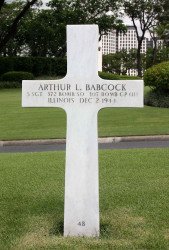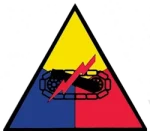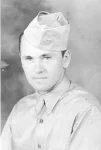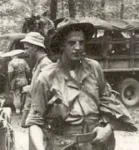S/Sgt. Arthur Lee Babcock was born on December 9, 1921, in Alameda, California, to William H. Babcock and Bird Brown-Babcock. He had three brothers and a sister. One brother died in 1936. At some point, his family moved to 615 North Eighth Avenue, Maywood, Illinois, where he attended Lincoln Grade School and graduated from Proviso Township High School in 1939. On February 16, 1942, he registered with Selective Service, stated he was unemployed, and named his father as his contact person.
Arthur was inducted into the US Army on July 3, 1942, in Chicago and assigned to Signal Corps before being transferred to the Army Air Corps because of his scores on the Army General Classification Test. His Service Number was 36, 357, 180. What is known about his training is that he trained at Lakeland Army Airfield, West Palm Beach, Florida, Martindale Army Airfield, San Antonio, Texas, Laredo Army Airfield, Laredo, Texas, Lowery Army Airfield, Denver, Colorado. It is known that Lowery had a gunnery school and he most likely qualified as a waist gunner there. He was next sent to Muroc Army Airfield, Muroc, California. During this time, in 1943, he married Ruth J. Feckner. He would become the father of a daughter.
He was sent overseas where he became a member of the 307th Bombardment Group (Heavy), 372nd Bomb Squadron of the 13th Air Force, and a member of a B-24 crew at Munda Airfield, New Georgia Island, on January 28, 1944. The plane’s Serial Number was 44-41400. In February, the squadron were transferred to Truk Island and remained there util April 29, 1944, when it was moved to Mokerang Airfield, Los Negros Island. The squadron again moved, on August 24th to Wakde Airfield, Wakde Island. Next they moved to Pitu Airfield, Morotai Island on October 18, 1944. While this was taking place. Arthur’s brother, William, was reported Killed in Action.
According to documents, his unit was involved in the Battle of Leyte. His plane was reported missing on December 2, 1944, near Cabu Island, during the Battle of Leyte. It was reported that Arthur’s plane and another B-24 collided and went down killing all the members of both plane crews. According to other plane crews, the planes were going through a cloud while flying off the coast of Cabu Island, when they saw a huge explosion to their left. It was 12:43 pm. Next they saw four large sections of B-24s falling from the sky and hitting the island.
A telegram was sent to his mother from the War Department.
MRS RUTH BABCOCK
615 NORTH 8TH AVENUE
MAYWOOD ILLINOIS
THE SECRETARY OF WAR DESIRES ME TO EXPRESS HIS DEEP REGRET THAT YOUR HUSBAND STAFF SERGEANT ARTHUR L BABCOCK HAS BEEN REPORTED MISSING IN ACTION SINCE TWO DECEMBER IN SOUTHWEST PACIFIC AREA PERIOD IF FURTHER DETAILS OR OTHER INFORMATION ARE RECEIVED YOU WILL BE PROMPTLY NOTIED PERIOD
ULIO
THE ADJUTANT GENERAL
A letter quickly followed the telegram.
Mrs. Ruth Babcock
615 North 8th Avenue
Maywood, Illinois
Dear Mrs. Babcock:
This letter is to confirm my recent telegram in which you were regretfully informed that your husband, Staff Sergeant Arthur L. Babcock, 36, 357, 180, Air Corps, has been reported missing in action since 2 December 1944 over the Southwest Pacific Area.
I know that added distress is caused by failure to receive some information or details. Therefore, I wish to assure you that at any time additional information is received it will be transmitted to you without delay, and, if in the meantime no additional information is received, I will again communicate with you at the expiration of three months. Also, it is the policy of the Commanding General of the Army Air Forces upon receipt of the “Missing Air Crews Report” to convey to you any details that might be contained in that report.
The term “missing in action” is used only to indicate that the whereabouts or status of an individual is not immediately known. It is not intended to convey the impression that the case in closed. I wish to emphasize that every effort is exerted continuously to clear up the status of our personnel. Under war conditions this is a difficult task as you must readily realize. Experience has shown that many persons reported missing in action are subsequently reported prisoners of war, but as this information is furnished by countries with which we are at war, the War Department is helpless to expedite such reports. However, in order to relieve financial worry, Congress has enacted legislation which contains in force pay, allowances and allotments to dependents of the personnel being carried in a missing status.
Permit me to extend to you my heartfelt sympathy during this period of uncertainty.
Sincerely yours,
(signed)
J. A. ULIO
Major General
The Adjutant General.
Records show the crash site for the plane was not found until August 23, 1945. His remains were described as being decomposed. Sewn into his pants was his full name and serial number which identified his remains. His remains were taken to the United States Armed Forces Cemetery #2, Cebu, Philippine Islands and buried in Plot 2, Row 8, Grave 534. He was buried in the cemetery because dental records had not arrived to confirm identification.
In a letter, dated September 11, 1946, informed his wife where Arthur was buried and the location of his grave in the cemetery. She was also informed that at a future date she would receive information on what her options would be for his final burial. Another letter dated November 6, 1947 was mailed to her by the Office of the Quartermaster General, Washington DC informing of her options for his final burial. She was also was asked to fill-out and return an enclosed form. She did not return the form so the OQMG reached out to the American Red Cross in an attempt to reach her. It was from the Red Cross that the OQMG learned Arthur’s wife had remarried. This made his father his legal next-of-kin.
William Babcock received a letter, dated July 26, 1948, informing him of his options for Arthur’s final burial. He was asked to fill-out the enclosed form and return it to the Office of the Quartermaster General in Washington. The form was received by the OQMG on August 19, 1948, indicating that his father wanted Arthur buried in an American Military Cemetery. On June 16, 1949, S/Sgt. Arthur L. Babcock was buried in the new American Military Cemetery, outside of Manila, with full military honors in Plot F, Row 1, Grave 48. The flag that covered his casket was sent to his father with a letter.
S/Sgt. Arthur L. Babcock, ASN 36 357 180
Plot F, Row 1, Grave 48
Headstone: Cross
Ft. McKinley U. S. Military Cemetery
(Manila, Philippine Islands)
Mr. William H. Babcock
615 North Eighth Avenue
Maywood, Illinois
Dear Mr. Babcock:
This is to inform you that the remains of your beloved ones have been permanently interred, as the recorded above, side by side with comrades who also gave their lives for their country. Customary military funeral services were conducted over the grave at the time of burial.
After the Department of the Army has completed all final interments, the cemetery will be transferred, as authorized by the Congress, to the care and supervision of the American Battle Monuments Commission. The commission will have the responsibility for permanent construction and beautification of the cemetery, including erection of the permanent headstone. The headstone will be inscribe with the name exactly recorded above, the rank or rating where appropriate, organization, State, and date of death. Any inquiries relative to the type of headstone or the spelling of the name to be inscribed thereon, should be addressed to the American Battle Monuments Commission, Washington D. C. Your letter should include the full name, rank, serial number, grave location, and name of cemetery.
While interments are in progress, the cemetery will not be open to visitors. You may rest assured that the final interment was conducted with fitting dignity and solemnity and that the grave-site will be carefully and conscientiously maintained in perpetuity by the United States Government.
Sincerely yours,
(signed)
H. FELDMAN
Major General
The Quartermaster General







